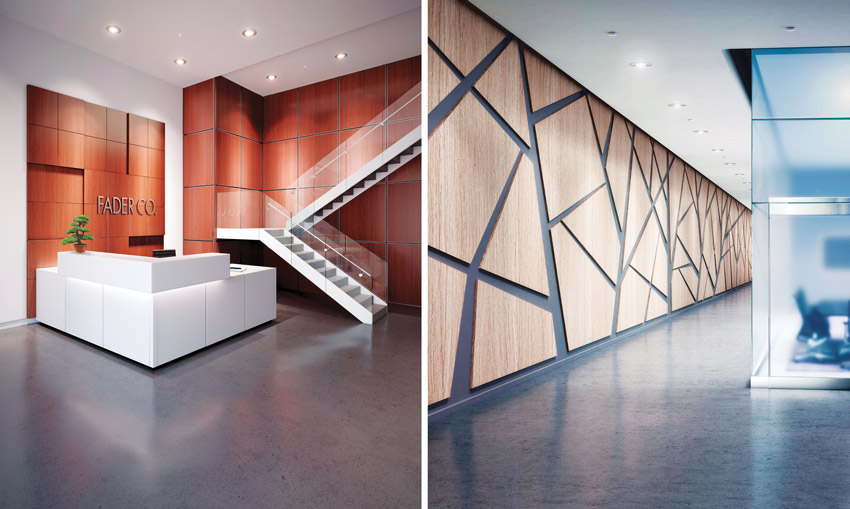The Evolving Workplace Environment
Wall Surfaces
With workplaces becoming more diverse and in many cases more open and fluid in their layout, walls become significant definers of spaces. The ways those walls are finished speak to the nature of the work environment not only in terms of the functional durability and suitability for a work setting, but also in terms of the impact that they have on the design and the perceptions of those who work in the indoor environment.
How indoor environments are perceived may have as much to do with generational differences than anything else. For the first time in history, it has been noted that our workforce comprises four generations, and each one has a different approach to work and the workplace environment. For example, the Bureau of Labor Statistics reports that workers who have been in the workforce for 10 to 20 years have changed jobs an average of 10.5 times compared to workers who have been in the workforce for more than 30 years averaging fewer than six job changes. Other surveys indicate the significance of health-care coverage in keeping or leaving a job. Overall, the old workplace models based on large, private, windowed offices reserved for people solely on the basis of rank and seniority, or the concept of working in the same place every day, have little appeal to modern workers who embrace technology to control the possibilities for when, why, how, and with whom they work. In light of these findings, it is not unreasonable to assume that new and different approaches to the interior design of a space are the norm for younger workers too.
One of the ways to take a creative approach to durable interior wall surfaces is to consider the use of wall panels that can be configured in standard or custom sizes, shapes, and finishes. Such panels can be applied to partitions and walls in creative ways. Commonly constructed of a 3/8-inch substrate laminated with PVC-free rigid sheet, panels of this type can be specified in standard sizes and a variety of thicknesses with reveal options. They can create bold and elegant interiors featuring wrapped square-edge panels, beveled-edge panels, and, for unfinished-edge panels, picture frame and thin trims. Such wall panels also offer dimensional flexibility for custom shapes and unique configurations. Finish options include a selection of solid colors and simulated woodgrain patterns. Photography, branding, and other graphics also can be incorporated across a series of panels.
In terms of installation, flexibility and ease are typical. Historically, the installation of demountable wall panel systems, used mostly in health care, education, and office buildings, was challenged by cumbersome clips and brackets. New offerings that use specifically designed hardware and accessories reduce installation time by at least 50 percent and allow for easy panel removal for routine maintenance and interior updates. Further, panels with wrapped edges can also be spliced in the field, avoiding the necessity for trims and exact panel dimensions.
How do such panels hold up over time? Manufacturers of such panels pride themselves on their history of interior wall protection with projects in place and performing well for decades. Some provide a wide range of wall protection products, including rigid sheet, handrails, crash rails, corner guards, and door and frame protection in a variety of materials based on the stress a wall needs to sustain. They bring that history and expertise to the wall panel design with options for both surface-mounted and recess-mounted applications. Overall, it is safe to say that these panels are more durable than laminate or stained wood applied to a wall and are produced to keep walls in workplaces beautiful and damage free years after installation.
Some manufacturers seek to share their extensive product knowledge by working closely with architects and designers on complex design issues, including making the best product choice for each application. Because the nature of the wall panel system is to provide protection of the wall beneath while offering a variety of aesthetic options, it is easy to work with such a manufacturer to create a space that complements a building’s design while remaining functional. Manufacturers can provide assistance from conceptual design to post-installation services for field-verified dimensions, technical support, product mockups, and sample coordination. They often work with architects and designers to help them select the product best suited for their building type considering factors that affect their building.
Amy DeVore, business development manager for Construction Specialties, comments on this role that manufacturers can play in providing new design options. “We redesigned the wall panel system because we recognized a need to provide solutions that weren’t available in the market. With rapidly changing trends, it is important to create products that solve frequent problems related to design and installation. As a result, we have a simplified wall panel system that we can confidently offer to design professionals knowing it will significantly add value by reducing installation time and expand the aesthetic options.”

Photos courtesy of Construction Specialties
Wall panel systems are available in solid and simulated woodgrain finishes that can enhance workspace environments in traditional or creative ways to create bold designs embraced by the people in the building.
Notice

www.asi-globalpartitions.com

CertainTeed.com/TargetedAcoustics

www.acrovyn.com/wallpanels

www.mockett.com/pcs61










